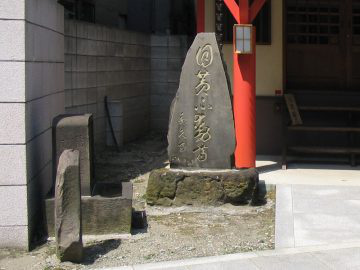
01. Meki Fudo
Eikyu-ji Temple, 2 chome 14-5, Minowa
A Fudo (short for Fudomyoo) is another manifestation of the Dainichi Buddha, the central Buddha of Esoteric Buddhism, who extinguishes evil and leads lost souls. It is said that outwardly, he is full of anger, but his heart is full of benevolence.
Meki Fudo are the Fudo whose eyes are colored yellow. It is one of the five Fudo of Edo whose eyes were colored white, red, black, blue, and yellow. In esoteric Buddhism, all the phenomena of the cosmos are manifestations of the five forces, earth, water, fire, wind, and sky, and the five colors of the Kings of Fudo are its representations.
The worship of Fudo began in Japan in the 9th century. The practice of painting their eyes in five different colors carried on until the 12th century.
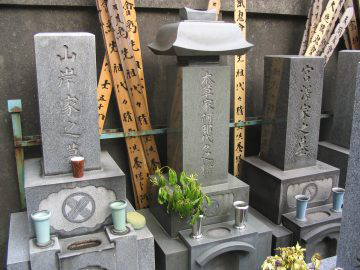
02. Tomb of Abe Tomonoshin Teruto
Metropolitan Historic Site
Bairin-ji Temple, 1 chome 27-3, Minowa
Abe Tomonoshin Teruto worked as a botanist during the Edo Period, and his tomb was designated a prefectural historical site (1928). He was called Shoou and Shoouken and was from Morioka clan.
According to the literary work "Sentetsusoudan zokuhen," by Tojo Kindai, he was born in 1650. However, calculating backwards from his death date of 1753, it would have made him 104 years old at the time of his death, and thus raising doubts about his birth date. In recent years, views on his birth date being around 1667 have arisen.
Teruto went to Morioka in 1727 and Yamanashi in 1728 to gather medicinal herbs. According to Bakufu historical data, it is clear that during that same year, a garden for medicinal plants in Kanda Konyamachi was lent to him, and in 1729, he set out to the Tohoku and Hokkaido regions for collecting herbs. However, regardless of this data, many things about his life are still unclear.
Yoshito learned about botany from So Senshun and Iwasaki Kanen, and Chinese literature from Tojo Kindai. In 1861, go aboard the Kanrin-maru (ship) dispatched by the Bakufu, he did surveys in Ogasawara. While doing jobs like this, he also worked on finding evidence to show how great his great-grandfather, Teruto, was born 1805, died 1870.
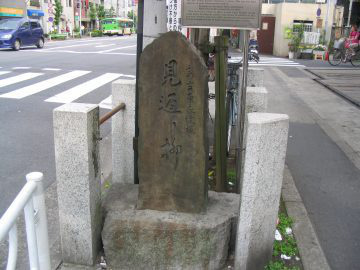
03. MikaeriYanagi (Looking-back Willow Tree)
4 chome 10-8, Senzoku
This is one of the memorial spots in the Yoshiwara licensed red-light district, a willow tree which is said to have been planted following another willow tree at the gate of Shimabara red-light district in Kyoto. This tree was called "Looking-back willow tree" because visitors returning home from the district looked back at this spot feeling painful reluctance to leave. This tree has been subjects of many Senryu poems such as
Kinuginu no usirogami hiku yanagi kana
Mikaereba ikenka yanagi kao wo uchi
New trees have taken its place several times because of the Great Kanto Earthquake and air-raids during World War II. The tree now standing used to be a little northward of its present site. It was transplanted due to road construction and re-zoning.
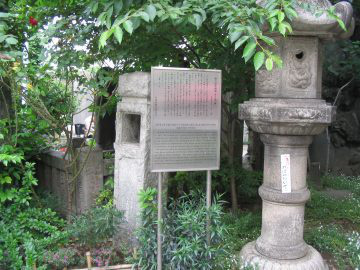
04. Site of the Shin-Yoshiwara Hanazono Pond (Benten Pond)
Yoshiwara Shrine, 3 chome 22, Senzoku
Until the early 17th century, this area was marshland with many lakes. In 1657, the wetland was reclaimed and the pleasure district, Shin-yoshiwara, was established. This pond was left alone and from a certain period, Benten Shrine was worshipped on its shores. Presently, this Benten Shrine is considered one of the shrines on the Seven Lucky Gods of Good Fortune in Asakusa and many come to worship it on New Year's.
The pond was called the Hanazono Pond or the Benten Pond. In the Great Kanto Earthquake of 1923, many people sought refuge by its shores and 490 of them perished. The giant statue of the Bodhisattva Avalokiteshvara near the Benten Shrine was built in 1926 in memory of their souls. Most of the pond was filled up in 1959 when the Yoshiwara Building was constructed and now only traces of it remain.
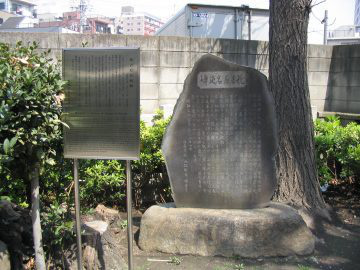
05. Monument in Memory of Hanano Yoshiwara
Yoshiwara Shrine, 3 chome 22, Senzoku
Yoshiwara was the only red-light district approved by the Edo government, and was set up in 1617 at what is now Ningyo-cho in Nihonbashi situated in Chuo City (Fukiya-cho Higashi-donari). The name of Yoshiwara is said to originate from the fact that the town was created by reclaiming a marsh area where ditch reed (Yoshi) grew in abundance.
The government executed the order to move the Yoshiwara red-light district to a suburban area due to the disastrous fire in 1657, and Yoshiwara was moved to the location of present-day Senzoku in Taito City (Senzoku-mura in Asakusa) in August of the same year. The Yoshiwara in the new location was called "Shin-yoshiwara" as opposed to "Moto-yoshiwara", the original red-light district.
Shin-yoshiwara was extremely prosperous as one of the greatest entertainment districts in Edo, became a part of the splendid Edo culture, and was the scene of many historical events, before it was abolished in 1958 with the establishment of the Anti-Prostitution Act. This monument in memory of Shin-yoshiwara was set up by local volunteers in 1960. The epitaph is written by Yamaji Kanko, a haiku poet, a researcher of the old senryu (old satirical seventeen-syllable poems), and a professor at Kyoritsu Women's University. Until the residence indication was changed in 1966, various town names that were related to Yoshiwara, such as Shin-yoshiwara Edo-cho, Kyo-machi, Sumi-cho and Ageya-cho, remained.
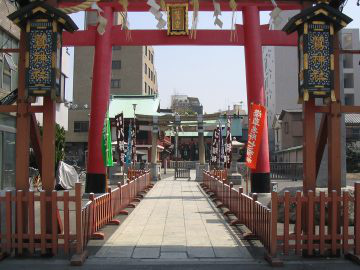
06. Otori Shrine
3 chome 18-7, Senzoku
There are two gods to which the Ōtori Shrine is dedicated Ameno-hiwashi-no-mikoto and Yamato-takeru-no-mikoto. According to the legend of the shrine, Yamato-takeru-no-mikoto felicitated his victory on his way back from his expedition by hanging a rake on the small shrine for Ameno-hiwashi-no-mikoto.
It occurred on the Day of the Cock in November, so that the day was subsequently chosen as the date of the festival. The Cock Fair was developed in the middle of the Edo Period as the poetical feature foreboding the arrival of winter. There is the First Cock Fair, the Second Cock Fair and, depending on the year, the Third Cock Fair. The year having the Third Cock Fair is said to have many fires.
Originally, the Cock Fair was a fair to sell rakes for practical use as a kind of agricultural product or implement. Subsequently, a rake was said to be useful in collecting fortune and assets. Therefore, it has been regarded as the charm for bringing about commercial prosperity or luck.
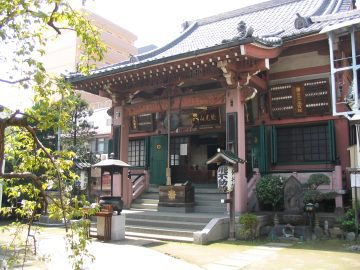
07■Tobi-fudo
Syobo-in Temple, 3 chome 11-11, Ryusen
Shobo-in temple is said to be first built in 1530. The name of flying God came from a legend: Once upon a time, the chief priest of this temple went to the Omine Mountain in Nara Prefecture to pursue his learning, he brought the principal image of Buddha with him to the mountain from his temple, but the principal image flew back to this place in Edo within one night and gave divine favors to the people.
In recent years, many people believe that the God of protection for airplane flights lives in this temple, and these people visit the temple to pray for the safety in air travel.
Also, an event of "Kiku (chrysanthemum) Festival" is held in October every year within the grounds of the temple.
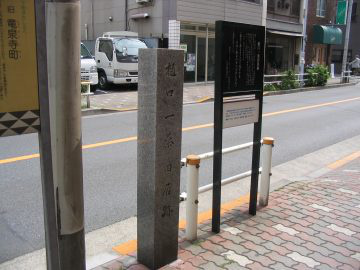
08■Remains of Higuchi Ichiyo's House
3 chome 15, Ryusen

09■Monument to Higuchi Ichiyo's Takekurabe
Ichiyo memorial park, 3 chome 19, Ryusen















